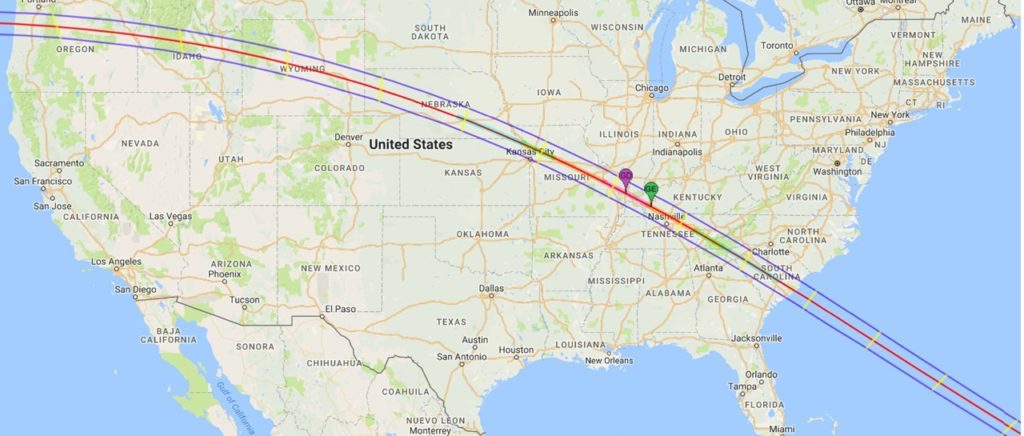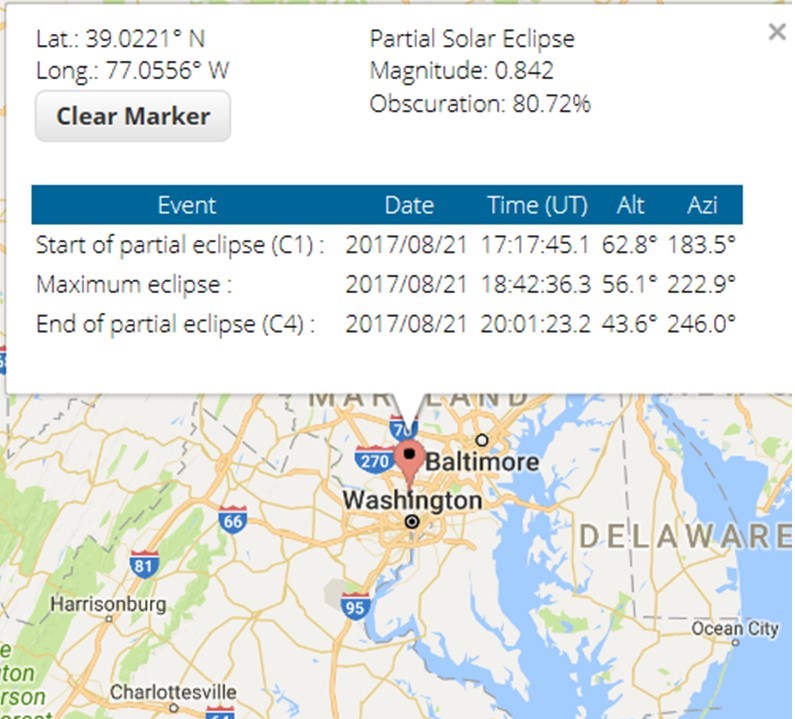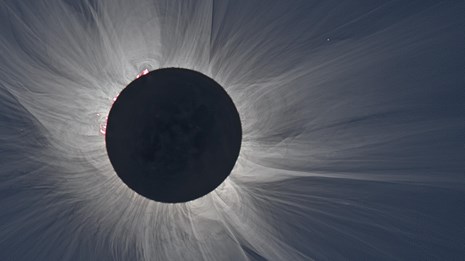If you’d like to capture a total eclipse of the sun with your camera, with all the drama of showing the sun’s corona and prominences exploding out into space, head to a spot on the red line below for an ideal view! The two blue lines define the limits of seeing a total blockage, with the central red line providing the longest period of totality. The border of Kentucky and Illinois (e.g. Shawnee National Forest) is the best spot (weather-permitting), with the maximum period of all: 2 minutes, 40 seconds. The pink part of the line is the sweet spot.
The map is taken from an interactive NASA website interactive_map where you can click anywhere to see the percent obscuration, relevant times of day, and durations. I included your backyard as an example:
This example, at the top of the DC Beltway, shows an 80.7% obscuration, 56° above the horizon, in the southwesterly direction. The “Azi” is the azimuth on a clockwise compass, with due North at 0°, East at 90°, South at 180°, and West at 270°. Caution: if you choose to stay in Maryland, you will see a minimum of 19.3% of the sun during the maximum eclipse, blowing out all corona and prominence details, and requiring you to have a solar filter on your lens throughout the eclipse.
The times are given as Universal Time, with a 24 hour clock, based in Greenwich, England. The start of the partial eclipse is given as 17:17:45.1, which is 5:17 and 45 seconds p.m. in Greenwich. For Eastern Daylight Time, subtract 4 hours. This gives a period of 1:17 p.m. – 4:02 p.m. (EDT) for the whole event, peaking at 2:42 and 36 seconds p.m.
Setup: You will want to use a big telephoto lens – the longer the better, and at least 300mm focal length. You want the sun to fill as much of the frame as you can. You must use a solar filter over your lens at any time other than totality! And use no solar filter when taking your money shots during totality. You’ll need a tripod. Make sure that your flash is off. Make sure that you have fresh batteries. You’ll need your lens on manual focus, pre-set to focus on the moon (i.e. ∞ ). You’ll need a cable release to fire the shutter. Plus you need to have the right exposure settings to capture what you’re interested in: outer corona, inner corona, chromosphere, prominences, Baily’s Beads – they all have different exposure settings that work best.
Obtaining a “perfect” picture of a total solar eclipse is not easy. Pictures that show the corona detail with prominences are the result of multiple images stacked together along with other post processing work. Prominences are several orders of magnitude brighter than the corona. They will be over-exposed in any image showing coronal streamers. And the corona will all but vanish in pictures showing prominences in detail. To produce a good composite picture is not too difficult, if you have the right equipment and are able to get a good sequence of images at varying exposures – think “HDR” bracketing.
The following site is an excellent “how-to” guide for chasing and photographing eclipses: https://www.eclipse-chasers.com/
Binoculars are the best eclipse viewing tool. (Don’t forget filters for them, too – you MUST have special solar filters for the partial phases, or you CANNOT use the binoculars!).




